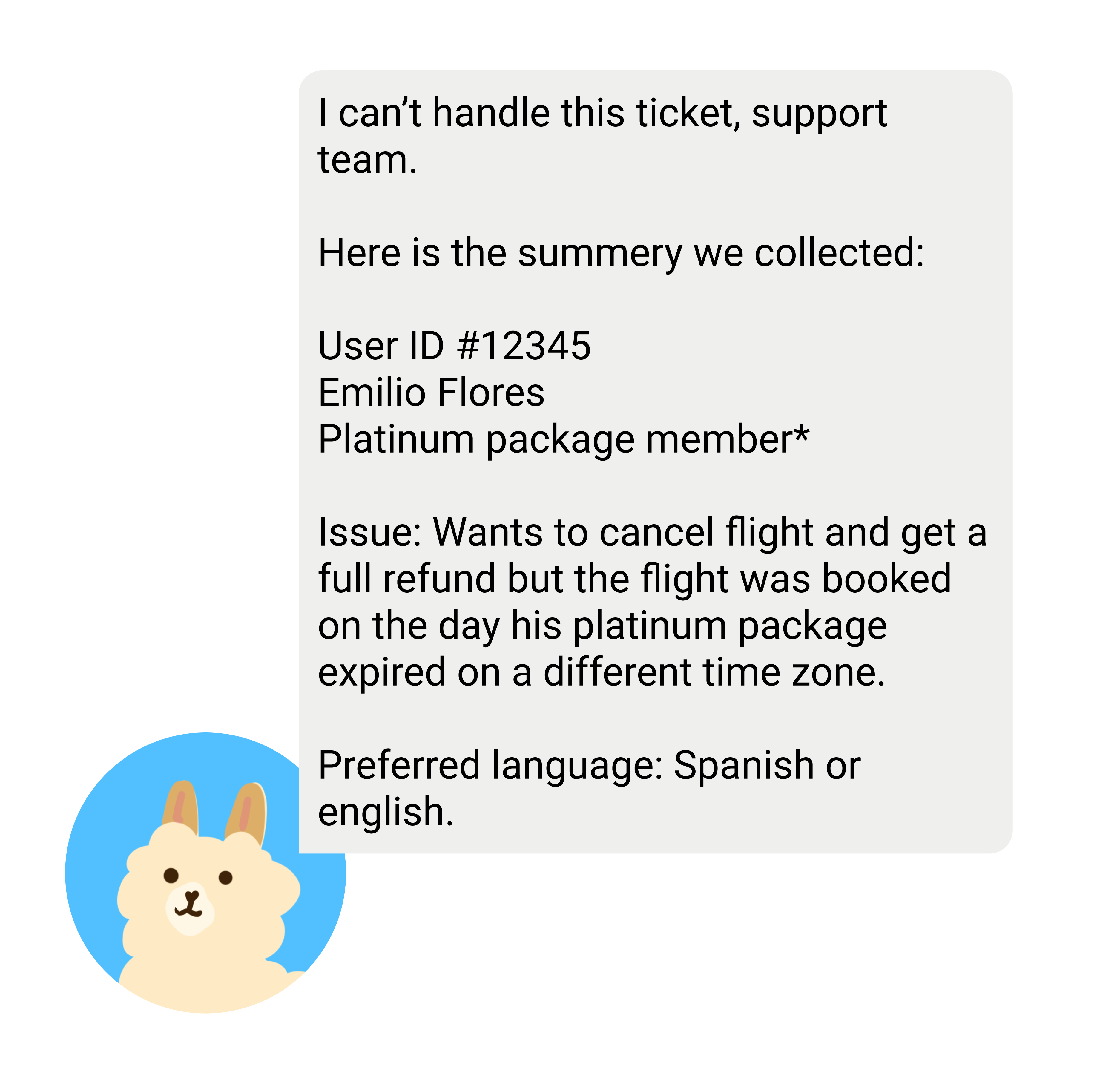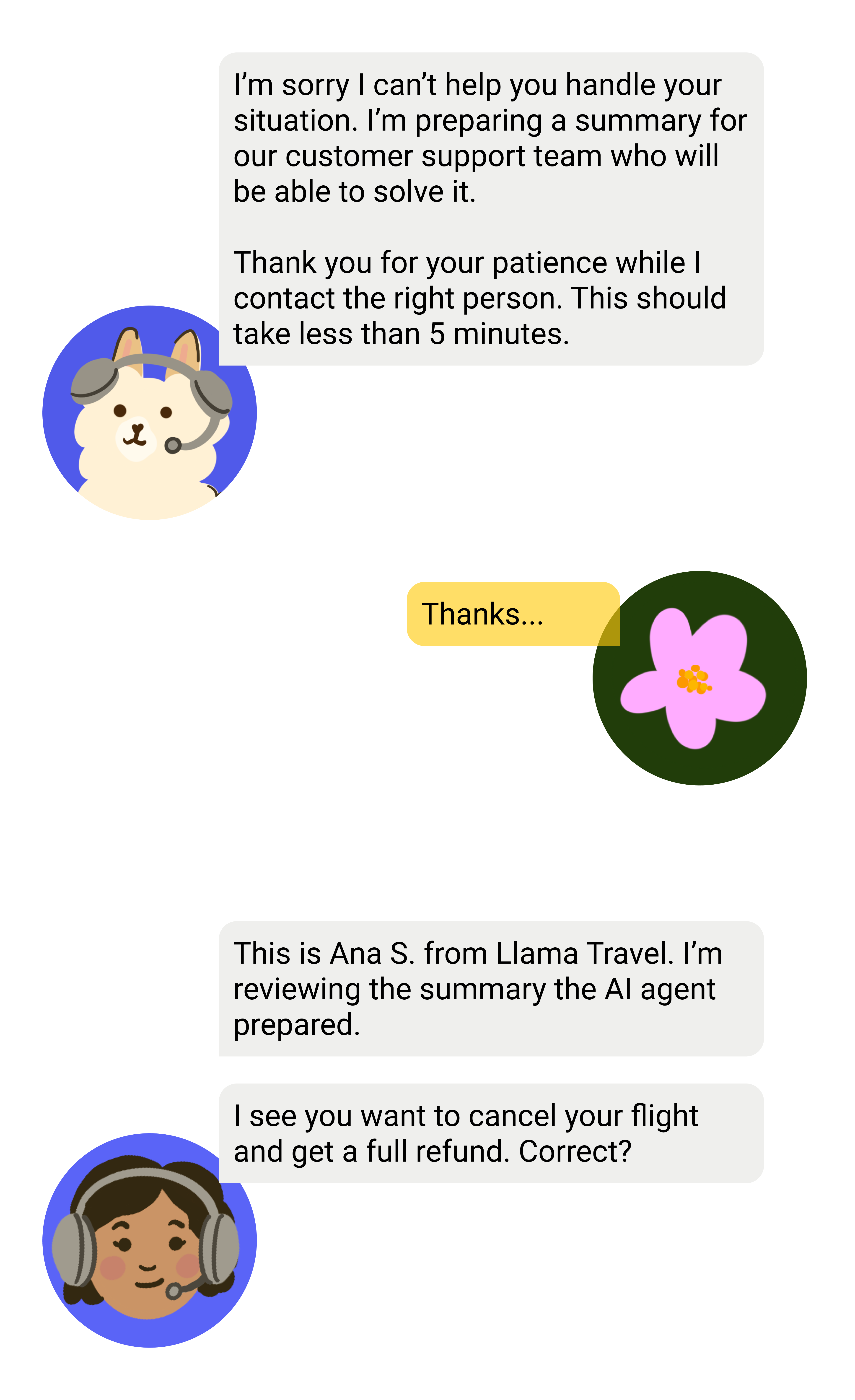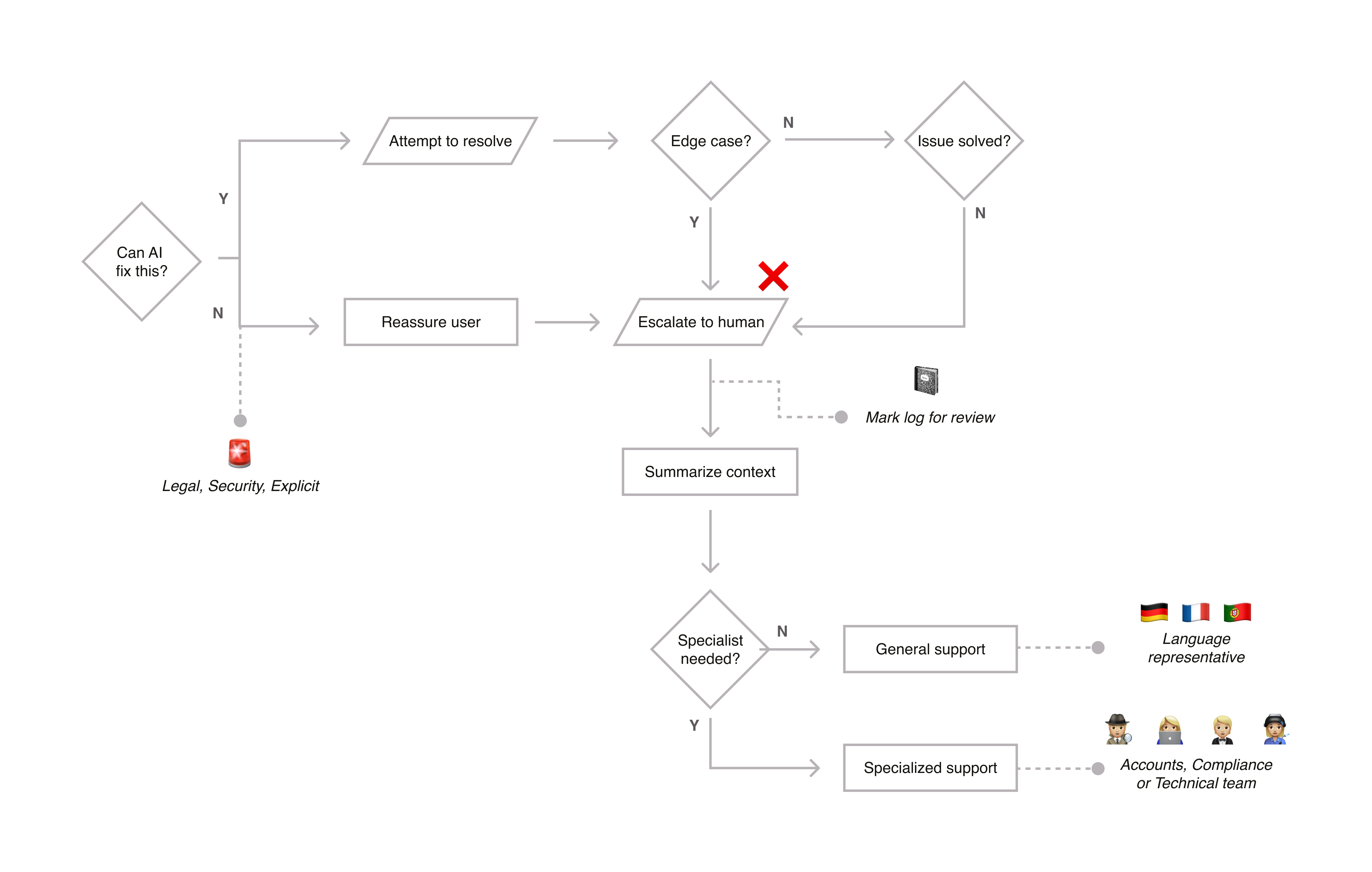Llama Travel 3
AI • Agents • LLM
September 10
When AI agents need to escalate to a human agent.
We made it! It's the final part on
Llama Travel and their AI agent
Llamita.
For this chapter, we’ll go over the things
Llamita can’t solve and how it can tag
in the customer engagement team—plus what
data it can collect so it can learn and
improve.
If you’re ready to land this case,
fasten your seatbelt! And if you need a quick
refresher before we leave high altitude, you can
read my other articles on LLMs and
AI agent basics.
Check out my earlier posts:
Llama Travel 1,
Llama Travel 2,
LLM Champion, and
LLM Master.
Let's go!

It's nightime and now we give Llamita a different hat
3) Escalation
So in the previous articles, we discussed how the AI
agent Llamita would assess what the user
needed and how it can call in other agents to handle
the request.
In the scenarios discussed, Llamita was able
to identify correctly and solve the issue. Now, we
are focusing on the cases where we
definitely need human expertise and empathy
to handle the situation.
We will divide this into three parts:
3.1 Escalation cases
3.2 Post and pre escalation
3.3 General tips.
3.1 Escalation cases
What cases should Llamita
not touch?
Quick answer: it depends, mostly on what the
AI agent’s training has prepared it to
handle. For example, Llama Travel might have
launched the agent in parallel while developing a
new premium package or feature.
So Llamita could answer basic questions, but
anything more in-depth would need a
human representative to provide details while
the documentation catches up.
This also applies to tracking cases manually; for
instance, if an airline is experiencing lots of
booking issues and strikes, the
customer engagement team wants to be hands-on
for anything related to it.
Editing Llamita’s original prompt to ask it
to escalate cases related to these specific topics
can help.
However, regardless of training, there are some obvious areas where we need special knowledge. Anything related to legal issues, security situations, edge cases, and users being explicit in their interactions requires human intervention.
Why? Let’s break those situations down:
-
Legal issues
AI is useful in many situations but an LLM is not a lawyer or legal expert. It’s not ideal if Llamita makes a mistake about a ticket price, but it’s a whole different world if it makes a mistake with legal repercussions.
Best case is to send this to a person who knows. -
Security issues
Similar to legal issues, imagine a customer’s credit card has a potential breach. Llamita can freeze the account and notify support, but a human agent should contact the individual to confirm actions and offer guidance tailored to the situation. -
Edge cases
As stated before, Llamita only knows what it knows. Identifying edge cases can be difficult, and you don’t want to escalate everything.
Set up Llamita to try handling the case and collecting as much information as possible before sending to a human. -
User being explicit
If the user is highly distressed (e.g., using ALL CAPS, which is the equivalent of yelling, or directly threatening legal action), we need a human to step in. While AI can identify emotions, it does not truly understand them—best to leave it to the people experts.

Here is an example summary of Llamita sends to the human agent when it escaltes the case
3.2 Post and Pre Escalation
Ok, so Llamita needs to send the case to the
right person. Now we need to prepare the human agent
and take notes for future cases.
Llamita can call another agent to make a
summary of the interaction with all relevant
information. That same agent can collect data from
other agents—for example, the number of attempts the
user has made to solve the issue, detected intents,
user’s profile info, how the user is feeling, and
any other relevant data to prepare the human
agent.
Basically, think:
what would you need to know to jump in and
solve the issue?
With the summary ready, we can hand it over to a
person to handle. The last decision
Llamita needs to make is: who to send it to?
Does the case need a specialist?
For legal, security, or special account issues, we
send it to the corresponding Accounts, Compliance,
or Technical team. For general queries, we send it
to the general customer support team, who can
clarify details with experts later if needed.
We also need to consider language. Let’s say for
Llama Travel we have in-house staff who speak
English, Spanish, and Portuguese, but the customer
is speaking German with Llamita. Oops! We can
be transparent and tell the user we will forward
their case to available languages and let them pick
one, or offer AI translation in their interaction
with the support team.
Since the situation couldn’t be handled solely by
AI, we want to take notes and flag the conversation
for the people training the AI agent.
From reading the conversation, I would adjust
documentation and prompts to better handle this
scenario.
I would also want to look at general stats for
Llamita:
- Does user sentiment change during interactions?
- How many messages are exchanged until a query is resolved?
- What is the chatbot abandonment rate?
- What correlations can we draw from the data?
- What are common cases where issues aren’t resolved?
- What issues receive negative feedback?
- What percentage of conversations escalate to humans?
- How quickly are cases being picked up and resolved post-escalation?
Finding patterns in the data helps identify
high-priority topics for improving
Llamita quickly. While it operates
independently for simple cases, Llamita still
needs human help to keep getting better and
better.
Also, make notes for false negatives,
scenarios when AI must say no, but users insist on
human contact. These are often about sensitive
topics like refunds, where Llamita can only
reassure and provide information.
This is still valuable data, so it’s important to
ensure cancellation policies and terms are as clear
and explicit as possible.

Llamita is transparent about how it sends the case to a human agent.
3.3 General Tips
Creating strong customer support agents is very similar to being a customer support agent yourself. Here is where I have some personal experience that comes in handy. Surprise! I was the secret agent all along!
In one of my previous lives I worked at a call center providing support to cable TV customers. It wasn’t for very long and it was my first job in college, but I learned a lot very quickly. The call center recruited in groups and trained us for about a month. I won’t go into details, but I remember feeling both prepared and unprepared by the time we hit the call floor.
Even after a month practicing new concepts, product specs, call scenarios, you can’t possibly cover every problem customers throw at you. The job required empathy and care. Here are some of the key lessons I picked up:
- Be empathetic about the situation. The first thing was always reassuring the user I’d do everything I could to help, that I understood their problem.
- Be transparent to the customer. When I was solving an issue, like adding info to their account, I’d tell the customer what I was doing. This avoided long silences and helped them feel things were being solved.
- Know when to escalate to a supervisor. When things went beyond me, I had to tag in someone who knew more.I wasn’t the expert, I was the first point of contact starting things off with a good first impression.
These learnings map well to building AI support agents:
- Program agents to reassure users and demonstrate understanding by summarizing their issue and offering help.
- Let agents provide status updates during issue resolution to maintain trust and transparency.
- Set boundaries for agent escalation: when a case is complex or emotional, route to human agents for deeper support.
For more details you’ll have to tune in for the next article! I recently got a GenAI customer support certificate, so we’ll put that new knowledge to good use!

It was me in the animal print all along!
I hope you liked this deep dive into building good AI agents. It’s always easier to understand new abstract concepts when we match them to an example, and for me, it’s even better when we add happy little animals to our analogies.
We worked on a specific case for a travel agency,
but customer service principles can be
generalized to other products.
It’s always about being empathetic and kind
to the customer and
knowing your product up and down, tail to
bottom.
Those rules apply whether you are selling flights to
Lima or flower bouquets. Be nice and wise, and you
will build the best agents in the world.
I have to confess there are also other areas of
knowledge I’ve drawn from to write these
articles.
Training an LLM was very useful to think about
information hierarchy and documentation, but my work
in diplomacy has been super useful.
I think in a future blog I will focus on
how to say no without saying no and telling
someone they are wrong in the most polite way
possible. Super useful skills for agents and for
life.
Just like I said before, know your product and be kind to the user, because you might end up being on the other side of an AI agent very soon.
That’s Enough About Me!
What do you think? What should I focus on next?
Which was your favorite animal drawing? I loved Llamita with the Chullo hat. Which was your favorite article? Since I wrote them, I love them all.
Let me know—shoot me an email! 😊
📩
sifuentesanita@gmail.com
